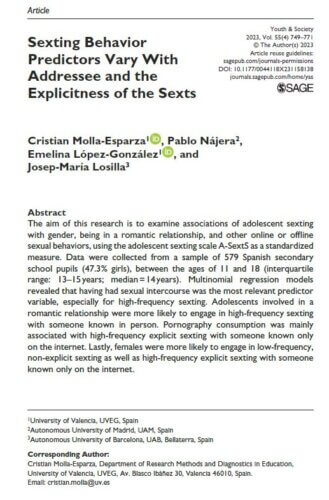Sexting
Sexting Behavior Predictors Vary With Addressee and the Explicitness of the Sexts
Open Access: No.
Abstract
The aim of this research is to examine associations of adolescent sexting with gender, being in a romantic relationship, and other online or offline sexual behaviors, using the adolescent sexting scale A-SextS as a standardized measure. Data were collected from a sample of 579 Spanish secondary school pupils (47.3% girls), between the ages of 11 and 18 (interquartile range: 13–15 years; median = 14 years). Multinomial regression models revealed that having had sexual intercourse was the most relevant predictor variable, especially for high-frequency sexting. Adolescents involved in a romantic relationship were more likely to engage in high-frequency sexting with someone known in person. Pornography consumption was mainly associated with high-frequency explicit sexting with someone known only on the internet. Lastly, females were more likely to engage in low-frequency, non-explicit sexting as well as high-frequency explicit sexting with someone known only on the internet.
Relevance
The study “showed associations between pornography consumption and sexting.” Furthermore, “the predictive power of pornography use was significant” for “high-frequency explicit sexting”with addressees unknown in person” – that is, sexting with strangers known only through online communication.
Citation
Molla-Esparza, C., Nájera, P., López-González, E., & Losilla, J.-M. (2023). Sexting Behavior Predictors Vary With Addressee and the Explicitness of the Sexts. Youth & Society, 55(4), 749-771. https://doi.org/10.1177/0044118X231158138

